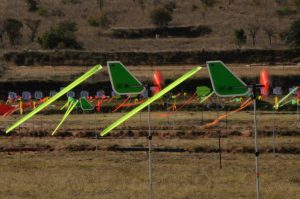Hey hot shots – here’s an introductory video on how to read the wind for precision rifle shooting. We’ll eventually get into advanced techniques, but this first video is going to start with the basics.
The language we use to describe wind conditions is easy to understand, but it’s not intuitive. I remember wondering whether a 3 o’clock wind was coming from or blowing towards 3 o’clock. So here’s an overview of the technical jargon and some ninja tips on reading the wind—let’s get started so we can all get on the same footing.
Wind Direction for Precision Rifle
Imagine you’re in a field facing the target. The target is at 12 o’clock.
- A wind blowing towards you, a head-wind, is a 12 o’clock wind.
- A tail wind that blows from your back—your six—is a 6 o’clock wind.
- A wind coming from your right, blowing across to your left, is a 3 o’clock wind.
- And a wind blowing from your left is a 9 o’clock wind.
Simple.
Wind Value for Long-Range Shooting
Another bit of jargon is to talk about wind value.
- A direct cross-wind, for example from 9 or 3 o’clock, is called a full-value wind. That’s because the wind is affecting the entire side of the bullet as it travels down range.
- A 12 or 6 o’clock wind is a zero-value wind. The point of the bullet or its base has a small cross-section relative to the area of the bullet’s side. A no-value wind will have no affect on the bullet’s horizontal trajectory. Now a 12 o’clock head wind will increase drag on the bullet, which will result in a lower point of impact on target (we’ll talk about that more in a bit), but it won’t affect your windage adjustment.
- A wind from 1 or 2 o’clock, or from 4 or 5 o’clock, is a half-value wind. Roughly speaking, it will affect windage half as much as a full-value wind.
So why do we need the labels? You obviously don’t need to know them to shoot the gun, or to become a marksman in precision rifle.
They give us a frame of reference to talk with each other. It allows a spotter to clearly tell the shooter what conditions he needs to adjust his scope for, or hold for. I can coach someone on the range to avoid the head wind, or jump on that light 7 o’clock condition. So it’s just about communication. Same as how the benchrest community tends to buy the same powder measures so we can share information more easily about our loads.
Bullet Point of Impact (POI)—How Does the Wind Change it?
Let’s get to the heart of the matter. A full-value wind will push the bullet in the direction of the wind, but it will also change the vertical point of impact. A 9 o’clock wind will push the bullet to the right and down. The higher the wind velocity, the farther down and to the right the bullet will impact the target. This is because of the direction of bullet spin.
Most barrels are right twist (you can request a barrel with a left twist, but for the most part your barrel will spin the bullet in a clockwise direction). For long-range rifle shooters, this will cause something called spin-drift, where the bullet will naturally drift down to the right over distance.
I’m talking about something additional to spin-drift. A strong full-value wind will deflect the bullet much more dramatically, even at short ranges.

A 3 o’clock wind will cause the bullet impact to move to the left and high. It will climb diagonally on the target—but not as much as a 9 o’clock wind moves the bullet diagonally in the opposite direction. This is because the bullet spin ‘bucks’ the wind.
Let’s talk more about the affect of a no-value wind. A 12 o’clock wind will increase drag on the bullet, which slows it down. The bullet will take longer to reach the target compared with a calm wind condition. This will cause the point of impact to drop on the target.
Similarly, a 6 o’clock wind will push against the base of the bullet, which will slightly increase the bullet’s velocity. A tail-wind will cause the bullet to climb vertically on target relative to a benign wind condition.
Now I’m talking about pure winds, with no other interference on the range. Next video we’ll discuss how to deal with some of those complications—to fine-tune your marksmanship for precision rifle shooting!
P.S. If you have a second, I’d love you to leave me a comment, and share this article with your followers! (It’s just below).

![]()
